May 10, 2021
What is the Difference Between Precancerous Skin Growths and Skin Cancer?
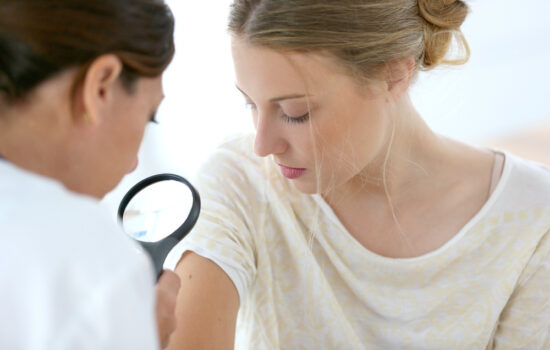
Discovering a new spot or unusual change in your skin can be concerning. Remember that a new spot on your skin doesn’t automatically mean that it’s cancer. In fact, most skin growths never cause problems and don't progress to skin cancer, especially when they are found early. Still, it’s a good idea to familiarize yourself with what precancerous skin growths are and how they differ from skin cancer.
What is a Precancerous Skin Growth?
Precancerous skin growths are abnormal areas that have developed on the skin that, if left untreated, could eventually turn into cancer. They are usually on the surface of the skin and typically develop in areas that have had a lot of sun exposure — head, hands, and forearms.
Older adults, primarily those over the age of 40, start to develop precancerous skin growths because they’ve had a few decades of sun exposure – especially if you’re a long-time Florida resident.
For people over age 50, sunscreen wasn’t available during their childhood like we have it now, which means damage was done in their early years that can lead to these types of skin growths now.
Precancerous skin growths can, however, appear at an earlier age, especially for those of us living in Florida, where we are outside in a lot of sunshine.
What Precancerous Skin Growths Look Like
Since precancerous skin can be a warning sign of future cancer, it’s important to know what to look for.
Precancerous growths on the skin can come in many different forms, including unusual bumps, blotches, and spots. Growths are often slightly raised on the skin and small, usually measuring less than one inch in diameter. Some are discolored, appearing brown, pink, red, gray, yellow, or white. Lesions can feel crusty, rough, hard, and scaly. Some may burn, feel tender to the touch, itch, or bleed.
Some of the most common precancerous growths include:
Actinic keratosis (AK): AK usually appears as small, scaly, or crusty patches that can be pink, red, or varying colors throughout the lesion. It is sometimes described as feeling rough, like a spot of sandpaper on the skin.
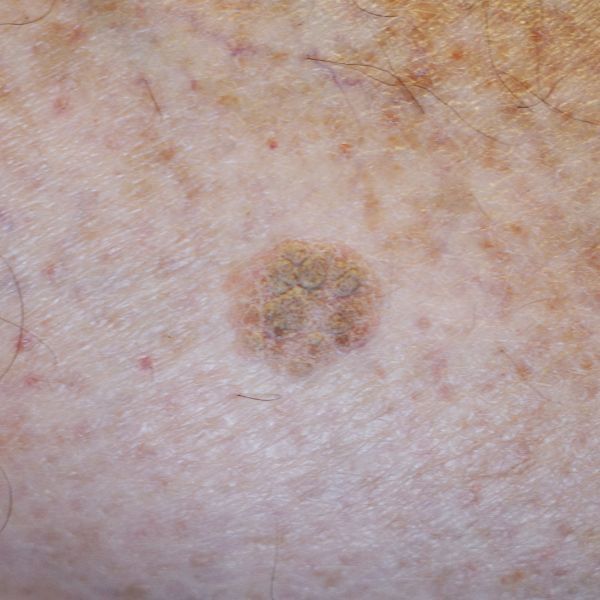
Moles: These are brown or black skin growths that can appear anywhere on the skin. They usually show up in early childhood and can develop through young adulthood (about age 25). Moles usually change very slowly but can become raised or change color. Some never change or even disappear.
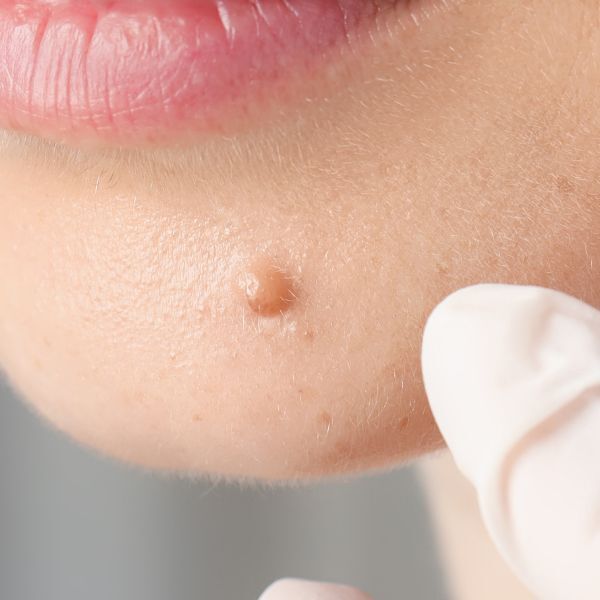
Atypical moles (Dysplastic Nevi): These moles are generally larger than normal moles and different in shape. New moles that develop after the age of 25 can also be considered atypical.
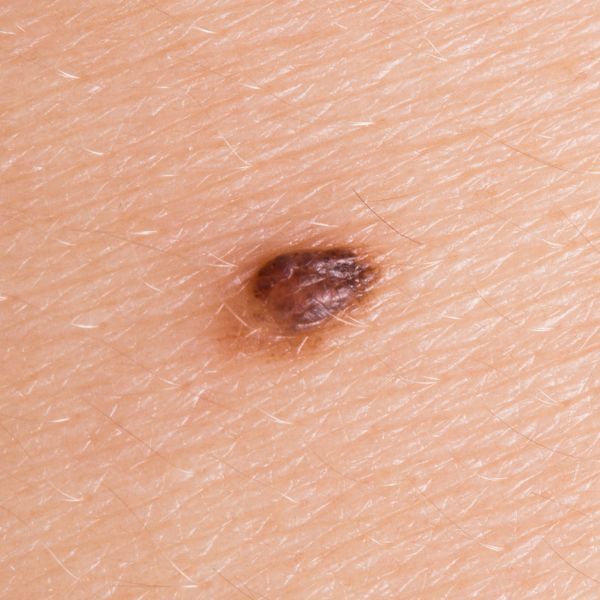
It’s possible you have other noticeable growths or marks on your body. Many people do! The good news is that these are usually harmless and are no cause for concern. These growths can include:
Skin tags: This is a general term for any small flap of tissue that hangs off your skin. They usually appear on the neck, chest, armpits, groin area, or under the breasts and are more common in women who are overweight and in older people. You may become aware of a skin tag when it becomes irritated by clothing or other skin rubbing against it.
Freckles: These small brown spots on the face, neck, chest, and arms are very common. Light-skinned people or those with light or red hair often have more freckles in the summer because of more sun exposure.
Age spots: The formal name for these skin discolorations (usually brown) are called lentigo. Lentigines are more common among people with fair skin. Usually caused by sun exposure, some spots are hereditary or caused by radiation therapy. They are often clumped together in an area, have smooth borders, and are painless.
Warts (Seborrheic keratoses): These growths are usually brown, tan, or black and are found on the chest, back, and head. They are more common with age but rarely lead to skin cancer.
When to See a Doctor About Skin Changes
Precancerous skin growths are usually treated by a dermatologist with recommendations for how to care for your skin to help prevent future growths. Early detection of changes in your skin is one of the most important things you can do when it comes to skin cancer prevention. Be sure to schedule an appointment with your dermatologist if you notice any unusual changes in your skin, including:
New growth or change
A former mole that is growing or spreading
Skin irritation or pain in a specific area
Bleeding and inflammation
A sore on the skin that won't heal on its own
Your dermatologist can accurately diagnose the lesion and recommend an effective treatment. Treatments for precancerous growths vary, ranging from topical medications to removal through freezing, light therapy, or surgery.
Remember, precancerous skin growths are not yet considered cancerous. But, they may result in one of the following types of skin cancer if you avoid getting checked out:
Basal cell carcinoma: This is the most common form of skin cancer, according to the American Cancer Society, making up the majority of skin cancer cases in the United States. If found early, it is easily treatable.
Squamous cell carcinoma (SCC): While less common, it’s more serious because it is more likely to spread to other parts of the body. It can be treated successfully if detected early. The cure rate is more than 90%. However, if it spreads (which happens in 1 to 5% of cases), it is much harder to treat.
Melanoma: This is a more severe skin cancer that is harder to treat. In as few as six weeks, it can spread quickly to other parts of the body or internal organs. Lentigo maligna, a flat brown patch with uneven borders, is considered a very early form of melanoma. While usually slow-growing, if left untreated, it will likely turn into melanoma skin cancer.
If your dermatologist removes a growth and it tests positive for skin cancer, you may need additional surgery to remove a larger area around the initial skin growth removal. You may also need to consult with an oncologist for further cancer treatments.
Check Your Body for Abnormal Skin Changes
Although skin cancer can appear anywhere on your body, most of the time, it develops on parts of the body that get the most sun, including areas such as the face, head, ears, neck, arms and legs.
Types of Skin Cancer
Skin cancer types include:
- Basal cell carcinoma
- Squamous cell carcinoma
- Melanoma
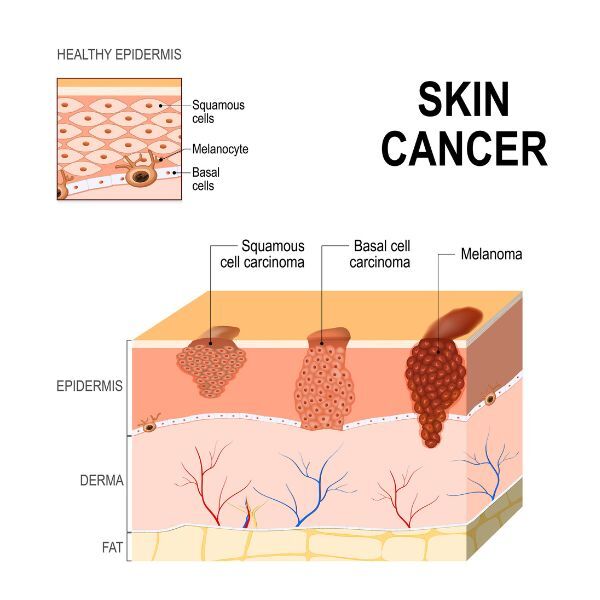
Basal cell cancers may have these characteristics, according to the American Cancer Society:
It looks like a scar with a flat, firm, yellowish area
Reddish patch that may be raised or itchy
Shiny, pearl-colored bump that may be tinged with pink, red, blown, or even blue
A pink growth with raised edges but a lower center; may have blood vessels that spread out like the spokes of a bicycle wheel.
An open sore that doesn't heal, or it heals and then comes back, may bleed, ooze or develop a crusty surface.
Squamous cell cancers may look like this:
Rough or scaly red patches, which can bleed or form a scaly crust
Raised growths or lumps
Open sores that don't heal or sometimes heal and come back
Wart-like growths
Melanoma can look like:
A new spot or a spot that is changing in size, shape, or color
A spot that looks different from other moles, freckles, or warts on your body
Some skin cancers don't include any of these symptoms. But, there is a handy acronym that you can use to help identify any abnormal skin changes. Watch this video to learn the ABCDE rule of skin cancer detection.
Be sure to talk to your doctor about any changes or new spots on your skin. If it is cancerous, the sooner it is diagnosed, the more effective skin cancer treatment will be.
Best Ways to Reduce the Likelihood of Developing Skin Cancer
The best way to reduce your risk of skin cancer is by protecting your skin. While past damage increases your risk, anything you can do now to protect yourself from additional damage is helpful.
Because Florida receives a lot of sun, be mindful of the climate and take steps such as:
Wear clothes that cover your body, even long sleeves, while being out in the sun, especially if you’re near the water. Rashguard bathing suit shirts are a good option.
Wear hats and sunglasses when you're out in the sun.
Try to stay in the shade during the peak sunlight hours of 10 AM-2 PM if possible.
Wear sunscreen with a solar protection factor (SPF) of at least 15. Make sure your sunscreen is fresh (less than a year old) to provide maximum protection. Reapply every 90 minutes or after swimming or sweating heavily. It’s a good idea to apply sunscreen every day to areas of the body that will be exposed to the sun, such as your face, neck, hands, and forearms. Apply 30 minutes before sun exposure, and be sure you apply enough to completely cover your skin.
Regardless of where you live, avoid using tanning beds. And, if you're over the age of 40, remember to schedule your annual skin screening.
Discover more Skin Cancer Prevention Tips for Florida Residents on our blog.
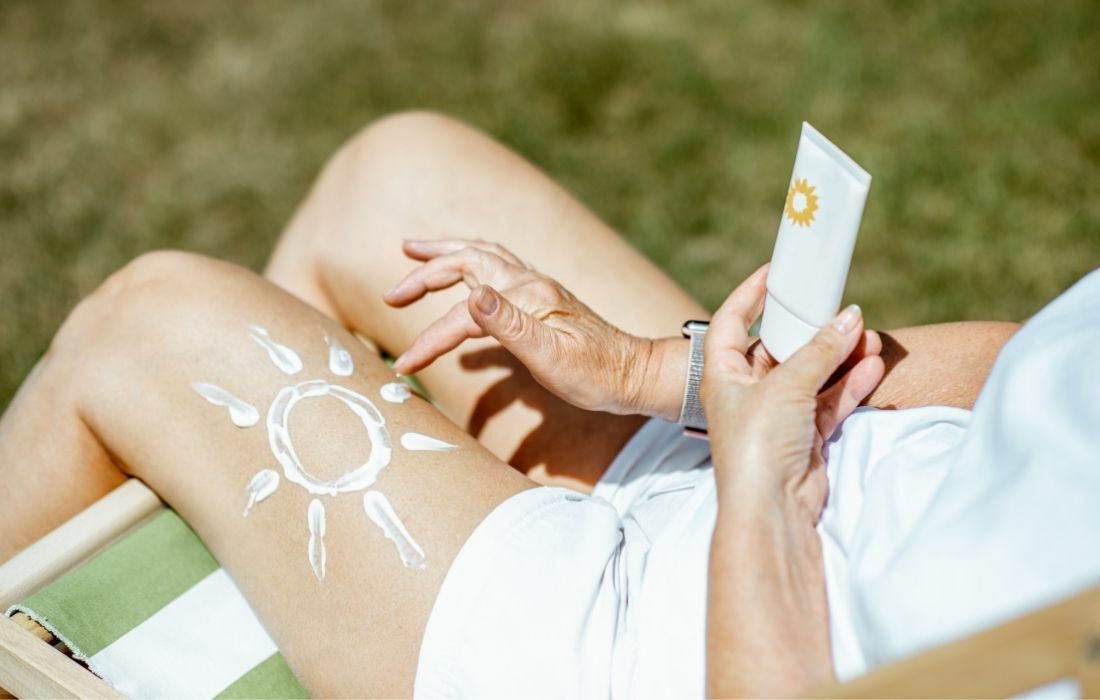
Florida Residents Should Never Skip Skin Cancer Screenings
It's important to schedule your annual skin checks to make sure that your skin is healthy and cancer-free. Even if you only live in Florida for part of the year, you’re still getting more sun than you would if you were up north. While self-exams are helpful, your doctor can provide a more thorough exam. Schedule your yearly skin screening today to keep your skin's health a priority.
If screening results come back abnormal or if you were diagnosed with skin cancer, the Cancer Care Centers of Brevard provides treatment for all types of skin cancers at locations in Melbourne, Merritt Island, Palm Bay, and Rockledge, Florida. Request a consultation with one of our skin cancer doctors to learn about your specific diagnosis and the next steps for treatment.
Original content published May 2021. Updated January 2025.
Categories: Skin Cancer